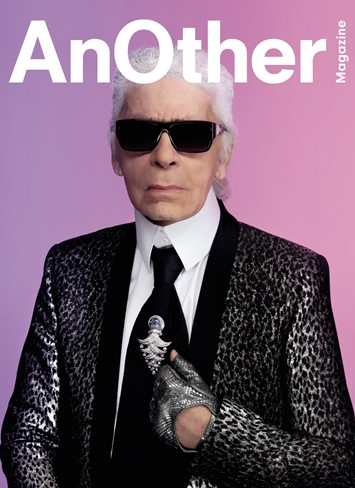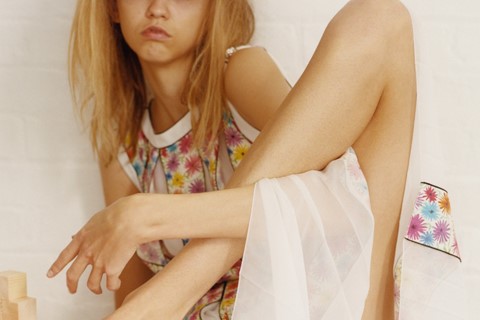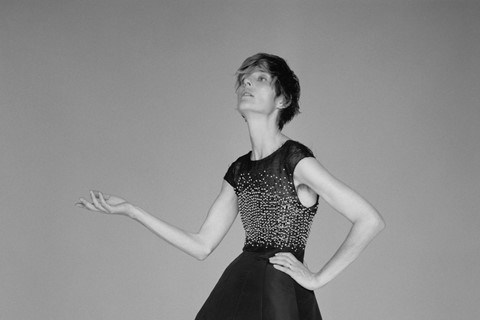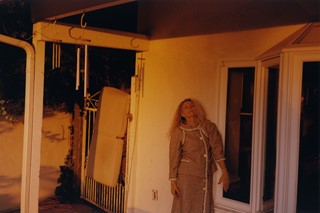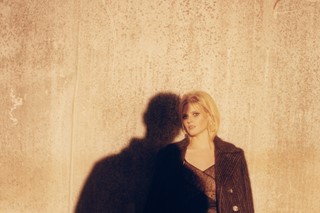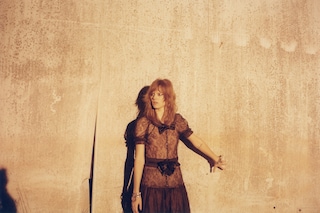This article was originally published on 19 February 2019.
Over the course of 2015, Susannah Frankel was invited to accompany Chanel’s singular designer during a hurricane of activity encompassing six fashion shows, studio fittings, the creative direction of the Hyères festival, a blockbuster London exhibition and the high-maintenance care of a certain photogenic cat. She even took an embroidery lesson courtesy of the petites mains of Maison Lesage – one of the Paris ateliers owned by Chanel. In an extraordinary in-depth interview, compiled from conversations conducted over twelve months, Frankel was allowed rare and privileged insight into Karl Lagerfeld’s complex and fascinating world.
Karl Lagerfeld is sitting at his large, ebony desk. It dominates one half of the intimate studio at Chanel’s famed rue Cambon headquarters.
“Chanel is quite modest in a way,” he says, and it is true that there is a discretion and ease around this storied name that quite possibly comes with the confidence that it is the single most successful fashion house in the world.
Four years ago, the space in question, once occupied by Gabrielle “Coco” Chanel herself, was redesigned. A sign reading “Mademoiselle Privé” remains attached to the door, just as it was throughout her tenure here.
“You cannot say this was the old studio,” though, Lagerfeld says. “The old studio had just three windows. There was no glass like this.” He gestures towards the reflective surfaces sparkling prettily in the light, pleased with the effect. “You see the photos from when she worked here. It was beyond modest. But all the studios were beyond modest. At Balmain, if you opened the doors away from the salons it was bordering unclean. At Patou – horrible. Nice salons, but behind the scenes – horrible.” He talks, as always, in the staccato rhythm that he has attributed to his formidable mother who, were her son not to get to the point quickly as a small child, would simply turn around and walk away, bored. Still, it’s worth noting that for all the brevity of his observations, Lagerfeld is the only remaining couturier to have witnessed such scenes. More broadly, he is a master of understatement, tending to play down his stature just as (he is the first to point out) Chanel plays down its own.
Back in the present, and “There are not so many people who work in here,” he continues. “There are only the heads of department. And it’s a historic building. Chanel owns the whole block. I could ask for a huge studio but I’m very happy here. I’m superstitious. I don’t want to mess up something that works only because of a folie de grandeur. I think it’s pretty chic with all the glass. And who has a floor in silver?” The silver marquetry beneath his feet is clearly precious, but its opulence is subtle, as opposed to dazzling. “I think over-decorated places are in bad taste,” he says.
It almost goes without saying that Karl Lagerfeld possesses the finest taste imaginable. His manners rival those of an 18th-century aristocrat, such is their refinement. He is tirelessly generous towards the person he is speaking to, despite the fact that what they ask him may not be especially inspiring. “Is that the best you can do today, Mrs Frankel?” he once wondered with a nod and a smile. Post-show he may have as many as 12 interviews lined up for television and more still for print. Blunt questions are met with remarkable humour, dignity and grace. As for his physical appearance – the bespoke Hilditch & Key white shirts with their four-and-a-half inch collars, the perfectly cut, sharp-shouldered jackets predominantly in black or grey, the fingerless gloves presently in silver python skin, the antique jewellery and tie pins... Today the latter is a delicate cluster of star and dark sapphires dating back to the late 1920s.
However distinctive, Lagerfeld’s elegance is rigorous over and above flamboyant. “People might not believe it, but I have no ego,” he says, which may indeed seem surprising given his position and the typically ego-driven world he inhabits. “I push the image of Chanel as much as I push my image,” he says. “I pushed her image as much as my ego pushed myself, without even making an effort. Some designers want their name on their work, but when I work for Fendi or for Chanel you never see my name imposed on them. If it’s good, people know; if it’s bad, people shouldn’t know. I don’t want to be in competition with Chanel or Fendi.” Still, he is famous. “Yes, I’m afraid. But fame is another thing with social media than it was. Today it is general, in the past it was elitist. People in the street didn’t know about Chanel. People today know about Chanel.” He once told me, “Even my voice is easy to recognise. When someone calls and they’ve dialled a wrong number, they recognise the voice. This happens very often: ‘You have a voice like Mr Lagerfeld.’” He is only too aware how ridiculous that might sound. “When I’m with Choupette,” he continues, “I don’t think about it.”
Ah, Choupette. The feline four-year-old love of Lagerfeld’s life has, he has said, made him a better person: “I think I was nasty and mean perhaps,” he explains. “But you know I hate to be in my houses without her.” He has five of these in Paris alone: one for sleeping, one for eating, one an office, one for photoshoots, and one for guests. “When she goes away to see her doctor once a month for two hours, I don’t like it. Even if she’s sleeping in a corner, I like her presence.” His face lights up at the mere mention of her name and he has a constant stream of photographs on his phone recording her every move, courtesy of one of two maids. “I get photos of what she’s doing this instant,” he explains, scrolling down the screen of his iPhone and sharing them, every bit the proud owner. “You admit, she is beautiful. Very.” Here is Choupette perfectly poised on a plump cushion, curled up fast asleep on a sofa, or – less obliging – ears pinned to her head, glaring straight to camera. “Look at this one. She’s furious. Furious. Françoise [one of the aforementioned carers] must have done something she didn’t like.” If I were Choupette’s maid, I say, I might think twice before sending that picture to him. “We keep a diary – everything has to be recorded,” he replies, deadpan.
There is certainly nothing nasty and mean about Karl Lagerfeld at this moment. Instead he seems positively relaxed – casual almost, warm, funny and expansive, leaning back in his quilted leather chair, removing his dark glasses to reveal intelligent brown eyes. A case in point: when the phone on his desk rings, he picks up the receiver and hangs up immediately, clearly with no interest whatsoever in who is trying to contact him. It’s safe to say that only the privileged few are likely to have access to his direct line, but he’s enjoying answering questions and not in the mood for taking calls, whoever it may be. His tireless curiosity and interest in responding, even though it’s safe to assume he has been asked anything and everything many times before, is hugely engaging.
In front of him are the tools of his trade – specifically a sheaf of lightweight A4 paper and pens for sketching. He draws often and – this is certainly not news – extremely well. He prefers to use Shu Uemura eyeshadow for colour as he finds it more beautiful than conventional materials. Often, though, his musings – and when he is sketching to illustrate a point, which he does regularly, that is just how it seems – are monochrome. “I work often for the bin,” he says, as having explained himself, penning a map of the street where he lives, say, or an example of a typical 1950s fashion illustration, he crumples the drawing and tosses it into that very receptacle. It is tempting to reach out and save it for posterity, but he’s having none of that.

“To be trained the way I was trained, people wouldn’t accept that any more,” he says, and it is true that the years spent working towards his chosen métier would appear endless by today’s less stringent, fast-moving standards. “When I started at Balmain as a studio artist, you had to sketch the existing dresses for the buyers and the clients. You saw the dresses during the collection and the rehearsal and then you had to sketch them, dress by dress, every embroidery, every button, every flower. Do that for three years and you know how to draw. There were two other artists, a boy and a girl, and they were paid along with me. Thank God my father was wealthy, because I think it was the best training.”
Much has been made of the fact that Lagerfeld’s rise to fame was through ready-to-wear, and at Chloé in the Seventies and Chanel in the Eighties he was doubtless a trailblazer in that field. However, despite the fact that he didn’t study fashion at school, having left his native Germany at the age of 17, he cut his teeth in the haute couture ateliers in Paris. “I didn’t like Balmain so much,” he says, more than half a century later. “The technique was very basic. When I was at Patou, I was much too young to be an art director, but they still had the premieres then from the Twenties and Thirties, and they taught me all the techniques. So I have the techniques and understand how it’s done. I never do it, I don’t have time, but if there’s a technical problem I can explain it, even in the worst situation.” It almost goes without saying that such experience is priceless.
All of those who collaborate with him – from the heads of the Chanel ateliers to his right-hand woman of 27 years, Virginie Viard – are at great pains to say that Lagerfeld’s drawings are precise to the point that a total look can be cut and finished down to the very last elaboration following their instruction.
“I’m just a sketching person, with very precise ideas,” he confirms. “There are not so many others working like I do and also who spend so much time. Because to make those sketches takes time.” He draws at home in the mornings, and “I’m always late because I don’t look at my watch. You know, when I sketch, time passes more quickly than I think. I think I’m there for an hour, in fact I’m there for three hours. It’s very funny, sometimes the things I do, I see them like an electronic flash. Yes. I see a thing and I can put it on paper,” he says.
Lagerfeld walks the line between extreme erudition and a love of popular culture. It is not uncommon for writers to raise their game in his presence, to draw him out on literature (he reads fluently in French, English and German), history, the work of his favourite philosopher, Spinoza, or knowledge of Nietzsche. He has a publishing house, 7L (a subsidiary of Steidl), and five years ago printed Nietzsche’s complete works (featuring the philosopher’s hand-written notes). “But I don’t want to play the intellectual, I hate that,” he says. “I like to be informed, I like to know everything, but I don’t want to make pretentious conversation or have discussions about subjects that I’m interested in. I like to know about all kinds of subjects, low and high, but I do it for myself. The last thing I want to be is a serious person. I can be serious but I don’t want to show it. It’s like being politically correct. Maybe I’m politically correct but don’t make a subject out of it. It kills advanced conversation.”

He is as equally well versed in tradition as he is in modernity, and is open-minded enough to embrace – or certainly listen to – the opinion of those he trusts, young and old, although he draws the line at fully engaging with technology. “I don’t like the Internet, but around me we have to do that. My assistants, my private secretaries, they all do it, so if I need something I have it in a second. I personally don’t do Instagram because one has to maintain a vague mystère. I don’t have to send images of a toile every five minutes, saying, ‘Now I’m doing that.’ This I don’t do. I don’t watch a lot of movies at home or anything like that, either. I like to live with my own imagination and my own images. I don’t want to be invaded. And I think it’s a good thing.”
In 2011, when we first met, he put this in a more extreme way. “I personally have nothing to say, nothing to explain. I make such big efforts to forget things. Non, non, non, I couldn’t tell the truth.” Instead, he is a magical and magnificent construct, willfully difficult to pin down. The mystery surrounding him is, in fact, profound, deeply romantic and at times poignant over and above vague, which means that the man behind it is afforded at least a certain degree of privacy. To probe too far into its depths would seem nothing short of vulgar.
Nonetheless – and almost paradoxically – his sensitivity to reality and instincts as to what people might want to see (and indeed, wear next) are finely honed in the extreme. Lagerfeld’s collections, and his shows for Chanel more than anything, may be an expression of a world better and more lovely than our own, but they are always very much of their moment. For example, in March last year, for the Autumn/Winter ready-to-wear show, a typically French brasserie was installed in Paris’s Grand Palais, and the accompanying clothes were bourgeois Parisian to match. Lagerfeld said at the time that the people in the country where he has chosen to live for the greater part of his life were suffering from an identity crisis. The show took place only months after the Charlie Hebdo attack, although he would have conceived the location long before that. Still, it was nothing if not prescient. Only an hour after this interview, one of many meetings throughout the year, gunmen and suicide bombers turned on Paris more broadly, a moment that will go down in history as horrific for France as 9/11 was for America.
To say that Karl Lagerfeld is prolific in no way does him justice. He designs eight collections a year for Chanel and four for Fendi. He is dismissive of the current discourse over whether fashion designers are forced to do too much. “I’m sorry. It’s like if football players accept money and then they say, ‘Je suis fatigué, c’est trop de matches.’ Non. Non. Non. You accept what you’re capable of doing. If you’re not, you go away. But I mean those people don’t have good lawyers. I can tell you my contract is very well made. There are marketing people but they never ever bother me. I work closely with Bruno [Pavlovsky, President of Fashion], Virginie [Viard, studio director] and Eric [Prfunder, image director]. All the other people, I never see them. We never have meetings. I don’t do meetings. I think about what I want to do and then I say I want to do it.”
Lagerfeld only travels for professional reasons (“I am not a tourist”), and time spent doing anything else, principally reading, feeds into that. He’s not overly interested in socialising, either. “I’m not a very sociable person,” he says. “I’m very at ease and good at small talk, but I don’t have much time. And social life bores me. People don’t bore me, social life bores me. But I’m perfectly happy. I adapt very well to our times. Better than many people. I have the opportunity to do a job that I love in the best conditions, because better conditions than this you cannot have. I don’t have to do the red carpet every week. I’m tired of photo calls. I can do it – I’m not the worst person to do it – but I don’t need that.”
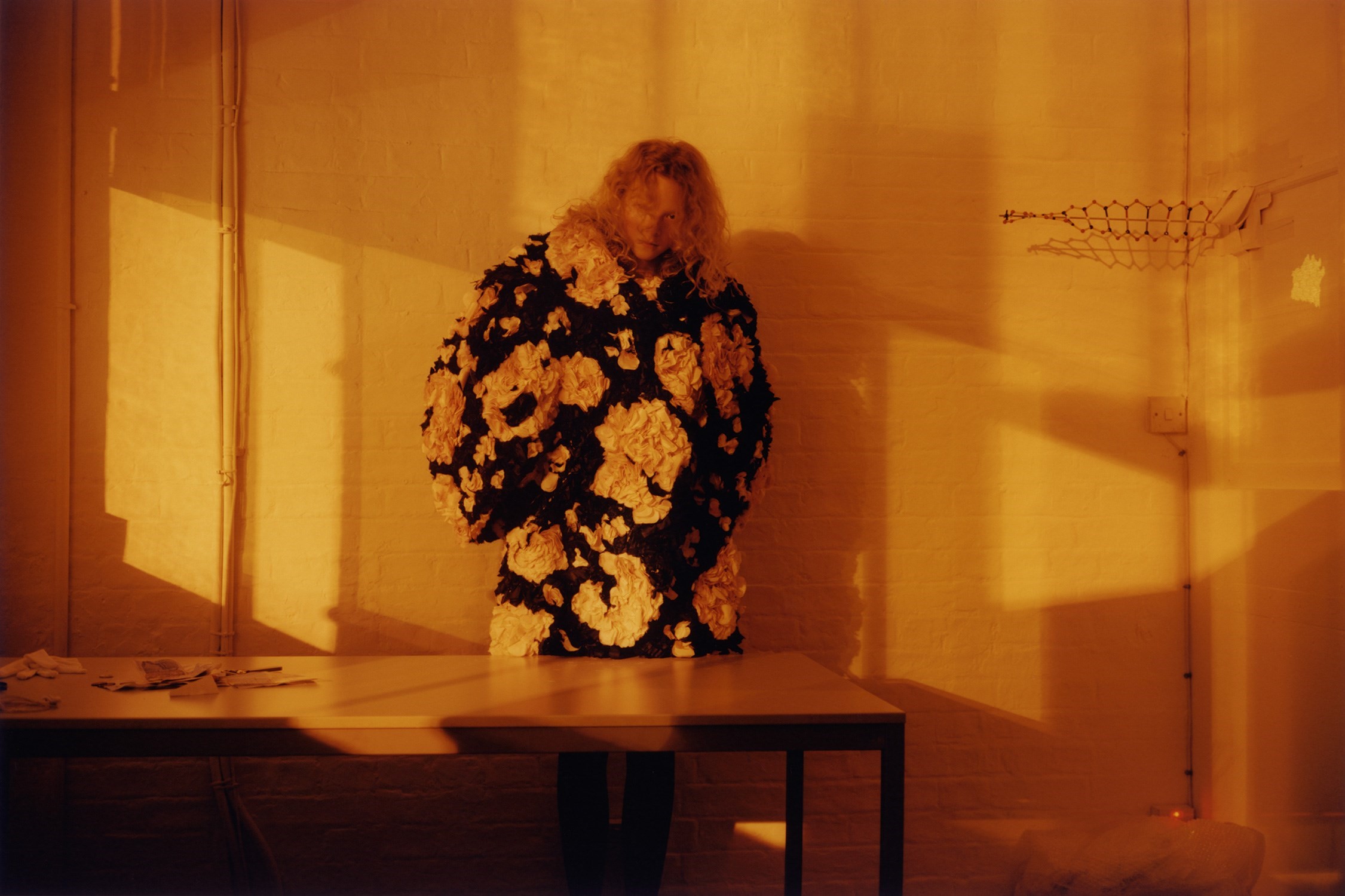
Away from his day job, he is also an art and fashion photographer (he shoots editorials for magazines across the globe and advertising for both Chanel and Fendi), an art director, and superstar in his own right. In 2004, he was the first designer to create a collection for high street retailer H&M, setting a revolutionary precedent. He says that appearing in the accompanying campaign made him a household name. All of this makes him the ultimate 21st-century designer. His model is the one that every other fashion house or designer must surely strive for. And none even come close.
Karl Otto Lagerfeld was born in Hamburg in 1933. His father, Christian, made a fortune manufacturing condensed milk and, as Hitler rose to power, moved his family to an isolated estate in the north German countryside. “My father was born in 1880,” he says, “and [people] had very strict standards at that time. My mother, no. My mother was very free-rolling, telling other people what to do but never doing anything herself. But she was fun – and funny.”
Elisabeth Lagerfeld, an early adopter of feminism, was also, her son says, the mother he deserved. “She was perfect for me as a child because I had a head like this [he gestures enormous], so somebody had to reduce it. I was beyond pleased with myself.” Even at age seven or eight he was an avid and precocious reader: Thomas Mann’s Buddenbrooks, ostensibly set in Lübeck (although the town is never mentioned in the novel) where his father had a factory, and with which he clearly identifies; Tolstoy’s War and Peace. “We lived on the Danish border and they were not like me, so I thought I was the king of kings. But I had to make an effort to get my mother’s attention. She spent her life reading on a couch during the day. She never lifted a finger, but she knew how other people should lift their fingers. For some people that could have been frustrating, but she wasn’t being unkind. She was always right. I think that’s génial.”
For all his mother’s laissez-faire attitude towards at least some aspects of life, there was still a certain formality at play, and he liked that too. “As a child, I never had a meal where I was not properly dressed. I wore what other people did not – Tyrolean outfits – and I loved that.” From an early age he also enjoyed the tailoring to which he remains attached. “There are photos people have sent me, because I kept nothing. You see all these schoolboys with little shirts and little knits made by their mothers, with short blond hair, and in the middle is a creature with long hair, a big bow and a black jacket. That’s me. Ten years old.”
If somewhat harsh in her relations towards her son, Elisabeth was also fiercely protective of him in the wider world. “I remember in the little village – it’s not so little now, it’s a town – one day we came upon a teacher who always told me, ‘Cut your hair!’ And he said to my mother, ‘Oh, madame, could you tell your son to cut his hair?’ And you know what she did? She approached the man, took his tie, threw it in his face and said, ‘Why, are you a still a Nazi?’ I will never forget that, this woman who for the village was beyond exotic. She had a perfect nose and was a size 38 even when she was 80. She used to say, ‘You look like me, but not as good.’”

Although he had two sisters, the eldest from his father’s first marriage, Lagerfeld says, “I’m a fake only child. I hardly knew [my sisters]. They were not brought up with me. They were sent to boarding school and married when they came out.”
It was Elisabeth who sowed the seeds for what would become her son’s vocation. “She told me, ‘You have to get out of here,’” he says. “‘There’s nothing here for you. This country died in 1933 so forget about it.’”
When Lagerfeld was employed by Chanel in 1982, it was anything but the fashion behemoth it is today. “I’m very lucky, because when I took over at Chanel everybody told me, ‘Don’t touch it, it’s dead,’ and so on.” The company then, as now, is owned by the Wertheimer family, who went into business with Gabrielle Chanel in 1924, buying a majority stake in Chanel Parfums with a view to expanding the production of No 5. Today, it is the property of third-generation brothers Gérard and Alain Wertheimer. The fact the company is privately owned means it has the luxury of keeping any figures under wraps. It is no secret, however, that it is the wealthiest of its kind. “Nobody has those numbers,” Lagerfeld says. “Alain told me to try to do something with it,” he remembers. “‘If it doesn’t work, I’ll sell it.’” I said, “Yes, but please know that I will do what I decide to do. Other people have no say in it.”
What he decided to do was to maintain the codes – the embroidered tweed suits, the little black dresses, the double-C logo, the pearls, the camellias, the number ‘5’, and much more – but imbue them all with a post-modern sense of irony that was very much of the moment. And, season after season, he is reinventing them still. The brilliance of Karl Lagerfeld is that his exceptional and passionate understanding of the past is never cumbersome. He breathes the present – and often the future – into everything he touches.
Virginie Viard started out with Lagerfeld as an intern at Chloé and moved to Chanel with him in the latter part of the Eighties. “I didn’t much like Chanel at the time,” she says. “I preferred Jean-Paul Gaultier, Martine Sitbon, but I always liked [Karl]. Chanel was just in one building. It was very small. Now it’s bigger, with a bigger team, but somehow we work like a small house still.”
It is Viard who interprets Lagerfeld’s sketches, and realises his vision, transforming it into clothes. There is, clearly, a huge amount of trust in their relationship, which spans almost 30 years. “He gives me the sketches,” she says. “He asks questions all the time, and I’m good with him if he does what he wants to do even if he’s not sure. After that I give him my favourites. I can change the colour, the fabric, maybe make it more real, but never the spirit. And then he gets the confidence and he sketches more, the sketches are really good. Every day there are new sketches.”
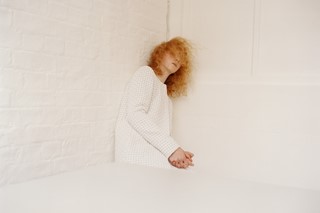
“Karl reminds me of an Olympic athlete,” says Amanda Harlech, who has worked with Lagerfeld since the late Nineties at both Chanel and Fendi, and who he often refers to as his “outside pair of eyes”. She curated the largest retrospective of his work to date, at the Bundeskunsthalle in Bonn last summer. “The more he does, the farther he gets,” she continues. “He never takes a holiday; he never turns off his brain, he constantly feeds it. He is at the height of his creative power and keeps getting better. That’s the way it is with artists – the more they see and express, the better they get.”
It is telling that Lagerfeld inspires huge loyalty from members of his inner circle. Charlotte Stockdale is another trusted member of the group: she has styled Fendi womenswear for eight years.
“Karl lives every day looking out at the world, and I mean the world, not just Paris where he lives, but everywhere,” Stockdale says. “He looks for the new, young, interesting, or the original take on whatever it might be. That applies to all walks of life, not just fashion, and that is why he is just extraordinary. His eye for spotting what’s good and what’s not is laser-like. That is so powerful. Karl doesn’t look back and he doesn’t let people throw him with their comments. I love his confidence and decisiveness. It’s both exciting and calming.”
Those who work closely with him are quick to confirm that the relationship is highly personal. “Every day we wait for him,” Viard says. “We love to be with him, we want to make him happy, to surprise him. That’s the energy we are working with here.”
Last November Lagerfeld travelled to London to pick up the Outstanding Achievement Award at the 2015 British Fashion Awards. A little over a week later, he was in Rome. He knows the Italian capital well, travelling there at least once every week for Fendi. The company is working on a philanthropic project to restore some of the city’s most prized landmarks, and Lagerfeld is documenting the process with photographs. Everything from the Trevi Fountain to Fendi’s headquarters in the Palazzo della Civiltà Italiana – a six-floor block of arches known locally as the “Square Colosseum”, and an icon of fascist architecture – is benefiting from the initiative. “It’s divine but borderline,” Lagerfeld says of Fendi’s new home, presumably referring to the politics behind its brutal aesthetic. “And it was never used as a building. It was built as the gate to the 1942 World Fair, which never happened. It’s a construction of unbelievable beauty. Unbelievable.”
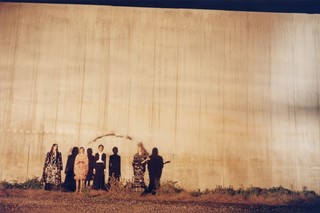
In early December 2015, Lagerfeld was in Rome, not for Fendi but Chanel, specifically for the house’s annual Métiers d’Art event, launched in 2002, which showcases the techniques of the Parisian ateliers that it began to acquire in 1984 (along with the purchase of costume jeweller Desrues) and later consolidated with the launch of its Paraffection umbrella (which translates as “for the love of”). Past Métiers d’Art collections were presented in London, Paris, Venice, and Dallas. In each instance, Gabrielle Chanel and the company’s connections to a chosen destination are drawn upon. Chanel lived in Rome for a time, on Via Giulia, one of the city’s most beautiful streets, and dressed actors for the films of Visconti and Antonioni. Those lucky enough to be invited to Chanel’s 2016 Métiers d’Art were offered a private view of the Sistine Chapel, a visit to Galleria Borghese, and a “secret tour” of hidden treasures, including a formerly bricked-in Renaissance shrine, a Mannerist and Baroque church, and a library of books dating back to the ninth century.
“Paris in Rome” – as the show was called – ended the day, and guests might have been forgiven for believing that witnessing such a degree of historic splendour beforehand would be a tough act to follow. Any doubters were proved wrong, however. The location was Cinecittà Studios, the legendary “Hollywood on the Tiber” founded by Benito Mussolini in 1937, and the birthplace of such epics as Joseph Mankiewicz’s Cleopatra, William Wyler’s Ben-Hur, Roger Vadim’s Barbarella, and Martin Scorsese’s Gangs of New York. Parts of Zoolander 2 were also worked on here... Most famously, Cinecittà was Federico Fellini’s favourite studio, specifically – and fortuitously – Studio 5, where La Dolce Vita, Casanova and many of his other classic films were realised. A brass plaque beside the entrance quotes the Italian director as saying: “When I’m asked what city I’d like to live in, London, Paris or Rome, my answer is Cinecittà… Cinecittà Studio 5 is actually my ideal place, this is how I feel before an empty stage, a place to be filled and a world to be created.” A photograph of his words graced the front of Chanel’s invitation.
A traditional runway show would never be enough. And so, on this occasion, guests sipped cocktails on an immaculately conceived, monolithic, flame-lit set of ancient Rome. They then filed into a second studio which screened Lagerfeld’s typically self-deprecating Warholian short Once and Forever, starring Kristen Stewart and Geraldine Chaplin as a young and not-soyoung Coco Chanel respectively.
Finally, it was on to the main event, where a complete Parisian street scene – imagine bars, brasseries, cafés, grocery stalls, and vintners – had been built over a six-week period. Openly steeped in nostalgia, it was drained of colour to resemble a black and white film.
It came alive with the clothes. Out came leather pasta farfalle, lovingly hand-crafted by master embroiderers, Lesage; feathers hand-painted to look like marble, courtesy of Lemarié; two-tone pumps with pearl straps and a heel decorated with a single pearl around which was wrapped a coiled silver snake, created by Maison Massaro; and necklaces of rosary beads made by Goossens worn over knitwear by Barrie.
Just like the set, the collection started out in black and shades of grey: the Chanel suit came with a trompe l’oeil long-line jacket (or was it a jacket over a skirt?) layered over skinny trousers and with a matching bag hanging from a signature gilded chain. Next were little black dresses in chiffon, pleated and frilled to perfection, spliced with panels of black lace. Later, colour came to the fore: faded pastels and burnished gold. With their tousled hair and smoky eyes, the models were a modern-day fusion of a young Brigitte Bardot and Anouk Aimée, the perfect embodiment of a young and hopeful French spirit.
Post-show, the backdrop sprang to bustling life and glorious Technicolor. Shop fronts opened to serve pasta, fine wine, gelato and offer bouquets. Quietly, standing above it all on a terrace looking down on his achievement, Lagerfeld greeted guests.
“For me, Paris and Rome are very close and it was a mix of both,” he told me. “For the moment what’s going on in France is so horrible, but I really didn’t know anything like that could happen when I made this city scene. To show a romantic Paris was the object. The reality is bleak, it’s not like this. I think it was an instinct, an evocation. It’s not just about a dress that people might have worn in the Fifties or Sixties, but more about how it could have been but never really was. It’s an idea of a better reality, of making reality like a dream.”
This story originally appeared in the Spring/Summer 2016 issue of AnOther Magazine.
